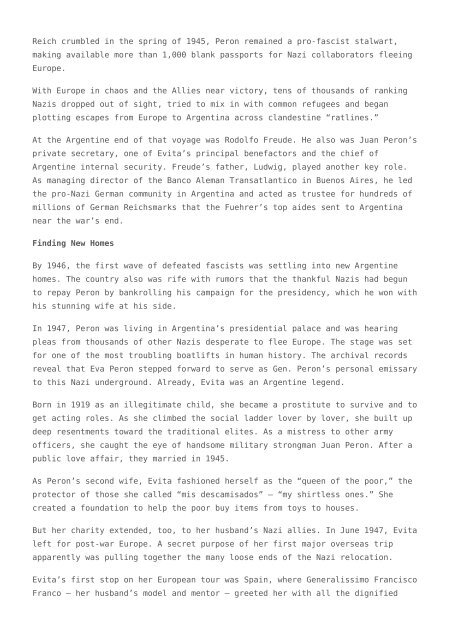You also want an ePaper? Increase the reach of your titles
YUMPU automatically turns print PDFs into web optimized ePapers that Google loves.
Reich crumbled in the spring of 1945, Peron remained a pro-fascist stalwart,<br />
making available more than 1,000 blank passports for Nazi collaborators fleeing<br />
Europe.<br />
With Europe in chaos <strong>and</strong> the Allies near victory, tens of thous<strong>and</strong>s of ranking<br />
Nazis dropped out of sight, tried to mix in with common refugees <strong>and</strong> began<br />
plotting escapes from Europe to Argentina across cl<strong>and</strong>estine “ratlines.”<br />
At the Argentine end of that voyage was Rodolfo Freude. He also was Juan Peron’s<br />
private secretary, one of Evita’s principal benefactors <strong>and</strong> the chief of<br />
Argentine internal security. Freude’s father, Ludwig, played another key role.<br />
As managing director of the Banco Aleman Transatlantico in Buenos Aires, he led<br />
the pro-Nazi German community in Argentina <strong>and</strong> acted as trustee for hundreds of<br />
millions of German Reichsmarks that the Fuehrer’s top aides sent to Argentina<br />
near the war’s end.<br />
Finding New Homes<br />
By 1946, the first wave of defeated fascists was settling into new Argentine<br />
homes. The country also was rife with rumors that the thankful Nazis had begun<br />
to repay Peron by bankrolling his campaign for the presidency, which he won with<br />
his stunning wife at his side.<br />
In 1947, Peron was living in Argentina’s presidential palace <strong>and</strong> was hearing<br />
pleas from thous<strong>and</strong>s of other Nazis desperate to flee Europe. The stage was set<br />
for one of the most troubling boatlifts in human history. The archival records<br />
reveal that Eva Peron stepped forward to serve as Gen. Peron’s personal emissary<br />
to this Nazi underground. Already, Evita was an Argentine legend.<br />
Born in 1919 as an illegitimate child, she became a prostitute to survive <strong>and</strong> to<br />
get acting roles. As she climbed the social ladder lover by lover, she built up<br />
deep resentments toward the traditional elites. As a mistress to other army<br />
officers, she caught the eye of h<strong>and</strong>some military strongman Juan Peron. After a<br />
public love affair, they married in 1945.<br />
As Peron’s second wife, Evita fashioned herself as the “queen of the poor,” the<br />
protector of those she called “mis descamisados” — “my shirtless ones.” She<br />
created a foundation to help the poor buy items from toys to houses.<br />
But her charity extended, too, to her husb<strong>and</strong>’s Nazi allies. In June 1947, Evita<br />
left for post-war Europe. A secret purpose of her first major overseas trip<br />
apparently was pulling together the many loose ends of the Nazi relocation.<br />
Evita’s first stop on her European tour was Spain, where Generalissimo <strong>Francis</strong>co<br />
Franco — her husb<strong>and</strong>’s model <strong>and</strong> mentor — greeted her with all the dignified


